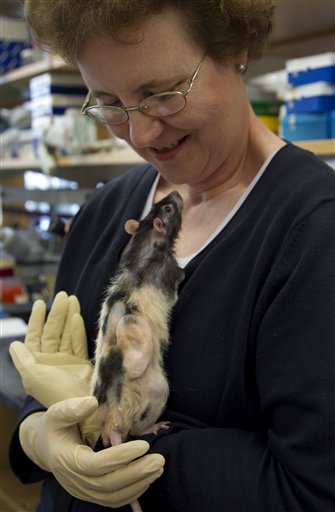BOSTON — Scientists are growing ears, bone and skin in the lab, and doctors are planning more face transplants and other extreme plastic surgeries. Around the country, the most advanced medical tools that exist are being deployed to help America’s newest veterans and wounded troops.
• In Los Angeles, surgeons used part of Michael Mills’ forehead to rebuild his nose after a bomb disfigured him in Iraq.
• In Pittsburgh, doctors used an experimental therapy from pig tissue to help regrow part of a thigh muscle that Ron Strang lost in a blast in Afghanistan.
• In Boston, scientists are making plans for the first implants of lab-grown ears for wounded troops after successful experiments in sheep and rats.
• In San Antonio and other cities, doctors are testing sprayed-on skin cells and lab-made sheets of skin to heal burns and other wounds. The ingenuity is impressive: One product was developed from foreskin left over from circumcisions.
Much of this comes from taxpayer-funded research. Four years ago, the federal government created AFIRM, the Armed Forces Institute of Regenerative Medicine, a network of top hospitals and universities, and gave $300 million in grants to spur new treatments using cell science and advanced plastic surgery.
“The whole idea is to bring all these researchers together to develop these great technologies that were in early science to eventually be ready for the troops,” said AFIRM’s recently retired director, Terry Irgens.
Now those who served are coming home, and projects that once had been languishing in labs are making strides and starting to move into clinics.
Strang is among those benefiting. The 28-year-old Marine sergeant from Pittsburgh lost half of a thigh muscle to shrapnel, leaving too little to stabilize his gait. “My knee would buckle and I’d fall over,” he said.
Now, after an experimental treatment at the University of Pittsburgh Medical Center, “I’m able to run a little bit” and play a light football game with friends, he said. “It’s been a huge improvement.”
It’s one example of the “new medicine” under way for wounded warriors.
GROWING NEW EARS
Up to a thousand troops might need an ear, and prosthetics are not a great solution. A rod or other fastener is required to attach them to the head. They don’t look or feel natural and they wear out every couple of years.
A matching ear grown from a patient’s own cells would be a huge improvement.
“People have been working on this for 20 years,” but haven’t been able to overcome obstacles to making it practical, said Cathryn Sundback, director of the tissue engineering lab at Massachusetts General Hospital.
Her lab thinks it has found the solution. Using a computer model of a patient’s remaining ear, scientists craft a titanium framework covered in collagen, the stuff that gives skin elasticity and strength.
They take a snip of cartilage from inside the nose or between the ribs and seed the scaffold with these cells. This is incubated for about two weeks in a lab dish to grow more cartilage. When it’s ready to implant, a skin graft is taken from the patient to cover the cartilage and the ear is stitched into place.
Scientists in her lab have maintained lab-grown sheep ears on those animals for 20 weeks, proving it can be done successfully and last long-term. They also have grown anatomically correct human ears from cells. These have been implanted on the backs of lab rats to keep them nourished and allow further research.
But that wouldn’t happen with ears destined for patients — they would just be grown in a lab dish until they’re ready to implant.
“We’ve solved all the technical problems,” Sundback said, and now they are ready to seek approval from the Food and Drug Administration to implant these into patients — probably in about a year.
“It’s amazing how much progress we’ve made with the AFIRM funding,” she said.
MUSCLES, BONE AND SKIN
A soldier lucky enough to keep his arms and legs after a bomb blast still might lose so much of a key muscle, like biceps or quadriceps, that the limb can’t be used properly.
In some cases, “the patient has lost so much muscle that there’s nothing left for the surgeon to sew together,” said Dr. Stephen Badylak, a regenerative medicine specialist at the University of Pittsburgh.
He is testing implants of “extracellular matrix” — connective tissue that holds cells together — to boost muscle mass. The matrix is thought to release chemical signals that promote regrowth of healthy tissue instead of scar tissue.
“It changes the body from thinking, ‘I need to respond to injured tissue,’ to ‘I need to rebuild this tissue,’” Badylak said.
The material is supplied by a private company — ACell Inc. of Columbia, Md. — and comes from pigs. The immune system tolerates it because it doesn’t contain cells. It comes in multi-layered sheets like slightly stiff gauze and can be cut or molded to fit the needed shape.
Strang, who lost half of a thigh muscle, is among the five patients treated so far in an 80-patient study.
The Department of Defense is sponsoring the study under way now, which includes non-military patients as well as former troops. The new study is measuring changes in strength and muscle volume, and doctors are aiming for the kind of quality-of-life improvement that Strang has enjoyed.
In other efforts, Pittsburgh and Rice University scientists are working on growing bone to fix jawbone and other facial defects.
Researchers at Massachusetts General and Rutgers University are trying to grow eyelid muscles. Blindness can result from not being able to close an eyelid.
Doctors also are testing various ways to make skin. In one method, doctors take a postage stamp-sized piece of a patient’s skin, process it in the lab and spray these cells onto a burn or other wound. The sprayer device that is used for this treatment is already licensed in seven countries, and AFIRM is sponsoring a study aimed at winning U.S. approval so the treatment can be offered here.
The second approach uses sheets of skin developed from cells in the lab that originally came from foreskins.
Send questions/comments to the editors.




Success. Please wait for the page to reload. If the page does not reload within 5 seconds, please refresh the page.
Enter your email and password to access comments.
Hi, to comment on stories you must . This profile is in addition to your subscription and website login.
Already have a commenting profile? .
Invalid username/password.
Please check your email to confirm and complete your registration.
Only subscribers are eligible to post comments. Please subscribe or login first for digital access. Here’s why.
Use the form below to reset your password. When you've submitted your account email, we will send an email with a reset code.